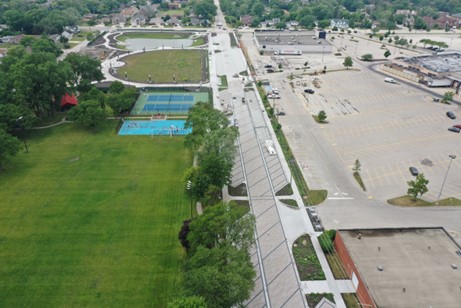Key takeaways
- Stormwater credits have the potential to boost local investment and attract businesses.
- Permeable pavers are feasible for multipurpose spaces
- There are opportunities for revenue when generating credits with green infrastructure
StormStore features Green Stormwater Infrastructure projects across the region to showcase the implementation of green infrastructure that helps alleviate urban flooding and generate stormwater credits in the MWRD pilot area. This edition, Village of Nile's Engineer Tom Powers talked with the StormStore team about the use of permeable pavers as a complement to a more extensive project in the area –The Greenwood stormwater basins – and how their idea of redesigning Church Street as a vibrant multi-use space for the community provided an opportunity to generate stormwater credits.
The Greenwood detention basin is an $11.3 Million project; according to Powers, MWRD awarded the Ville with a grant through the Stormwater Partnership Program to purchase the land to build it, a process made in collaboration with the Village Park District. This project created a massive basin of 4.5 Million gallons, expecting to help detain stormwater on the northwest side of Niles, an area historically affected by flooding. Besides detaining stormwater, the project created a new space for the community as it expanded the size of the Golf Mill Park from 4 acres to almost 10.
A Street of Opportunities
Church Street is conveniently located on the northern side of Golf Mill Park and the Greenwood stormwater basins. According to Powers, the community uses this street to host festivals and events like the Maria SS. Lauretana Society Festival, which is the largest Italian festival in the region. The Village saw an opportunity to support this and more community events by adding features to make this space more functional for people, making it more appealing to pedestrians, and envisioning a multi-use path with the capacity to host community events while expanding the public space of the already existing park. With a length of 1,307 Ft. from Greenwood Road to North Cumberland Avenue, the Village wanted to transform this place from asphalt to permeable pavers, adding greenery and trees, upgrading sidewalks, and making it more walkable while reducing the negative effects of asphalt, lowering the temperature on average 7ºF during the summer and reducing the noise caused by tires.
Why permeable pavers?
To designate the importance of this multi-purpose street space to the community, the Village decided to use specialty concrete pavers as an alternative to asphalt and included this additional cost in the original capital improvement budget. As non-permeable pavers were already built into the budget, when the idea to use permeable pavers was suggested, the change in the cost was determined to be incremental and worth the improvement to the overall Greenwood basin project. The Village started exploring the permitting process along with MWRD. Powers said that implementing permeable pavers not only has environmental and social impacts on the relationship with the community and the street, but the design can generate stormwater credits as Niles is part of the pilot area.
Source: Village of Niles, 2022.
Revenue opportunity?
Permeable pavers can be costly, especially if built as an upgrade from asphalt. However, the cost difference between pavers and permeable pavers makes it a competitive option when there is an opportunity of generating stormwater credits. The primary reason for this cost difference is that permeable pavers require deeper excavation for underground storage and infiltration of stormwater. As Niles is part of one of the eligible areas for the stormwater credit trading market, the incremental cost to install permeable pavers was a good investment, providing volume retention of 0.461 ac-ft, 0.146 of them eligible for credit trading, making it an opportunity of revenue to this municipality.
Within the watersheds, developers can comply with up to 50 % of their detention off-site by purchasing credits on other sites. For retention, this percentage varies depending on the site. Owning stormwater credits presents two opportunities for Niles. First, the Village could sell available credits to a developer and any revenues to offset the incremental construction cost on Church Street. Second, the Village could use the credits as part of an incentive package to attract regional investment in redevelopment.
One such example might include a redevelopment of the adjacent Golf Mill Shopping Center, also known as the dead mall, due to the numerous vacant storerooms. Powers mentioned that developers have plans to bring back this mall, redeveloping the entire area of 80 acres into a town center and providing retail, office space, and hospitality amenities. This could be an opportunity for Niles to sell the credits while incentivizing development in the area.
The Church Street permeable pavers is a part of the on-going Greenwood basin project that began before MWRD authorized the Stormwater Trading Pilot to begin in June 2020. As a result, the engineers at Hey and Associates were required to submit a revision of the Watershed Management Permit to allow the Village to generate stormwater credits. The project team worked with MWRD to explore options to make this project capable of generation credits.

Source: Ville of Niles, 2022.
Conclusion
As municipalities work to make their cities resilient to climate change, they face opportunities to upgrade and redesign their infrastructure by having people at the center of it. Niles saw the chance to upgrade Church Street and make it a joyful space for citizens while making it resilient and a solution complementary to the Greenwood stormwater basis. Any opportunity requires an investment, but the StormStore team applauds the ingenuity of the Village of Niles and believes there are many more opportunities in the region to build high-quality community-centered project that also offset the cost of construction and maintenance.
To learn more about this or other projects, visit the StormStore website. You can also find the credits available from this and another project on our credit registry page. Please get in touch with us and explore the benefits of StormStore to your projects.